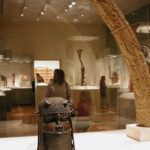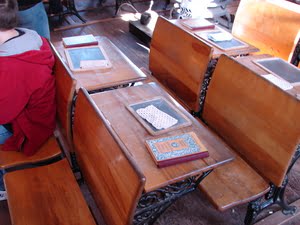Every painting, drawing, or photograph is a collection of dots and lines. Lines and dots are the building blocks of art. Dots may be big, small, thick, or thin. Lines may be straight, curved, zigzagged, parallel, weaved, vertical, horizontal, perpendicular, or angular. Lines and dots may be connected, or unconnected.
Look around you. Look at the edge of objects. Look at creases and bends. You are looking at lines. When you see filled in color, or edges where lines meet or intersect, you are looking at dots.
The use of lines allows artist to demonstrate delicacy or force. Thin lines connote a delicate look, while thick lines give art more drama. Curves may take us slowly uphill, or turn sharply twisting our mind as they turn. In addition to showing contour, lines can be used to show texture.
The artist’s use of lines gives you some idea of the plan or intent of his/her work. Lines are one of the few tools that an artist uses to organize his/her work. They are used to complete shapes and define a piece, or conversely, to create illusion and cause a work of art to appear that it is something that it is not. The use of lines for illusion is an example of creating implied lines. Implied lines are not present, but the viewer completes them in his mind.
Lines are also used in art to define focal points, define positive and negative space, and create the layout of the art work. Lines are not always visible in a work of art. Sometimes the organization of elements of art is along an unseen line, or geometric shape. For example, a painting may contain people, but in order to define the space, the people are arranged so that arms, legs, heads, a glance, and/or other body parts, if extended would create geometry. This is a great method for artists to achieve balance in their work.
In Michelangelo’s well known painting, “The Creation of Adam,” the extension of God’s arm toward Adam is along an unseen diagonal line. This gives the artist some bearing in creating the remainder of a scene or portrait. It helps keep things properly proportioned.
Lines and dots may also give the viewer some insight into an artists’ work through symbolism. Horizontal lines are said to suggest stability. Vertical lines are assertive, upward bound, as though they intend to defy gravity, or earthly boundaries. The use of pyramids in art is often associated with spiritualism, in many religions, including Christianity.
Some lines that are seen, actual lines, are very subtle, suggesting direction, bodily movement, or the movement of air.
Lines that one might consider view as defying natural law suggest a lack of order, chaos, or may propose a new way of thinking about something common place. That is what Picasso’s sharp angular lines, in three dimensions did. In some ways Picasso used lines to dehumanize his subjects and thus make them universal. The focal point of his cubism was not sensual, but matter of fact, suggesting there is some order to all that we see. Lines that are not organized as we think they should be cause us to ponder a work more closely, and question our own acceptance of the status quo.
Some terms associated with dots and lines with which art students should be familiar include the following:
Stippling is a method of drawing using small dots. A stippled picture may be composed entirely of millions of small dots. Stippling allows an artist to create texture.
Hatching involves using fine parallel lines. Hatching can be used effectively to create the illusion of hills, or waves. When sets of parallel lines are used to create artistic effect it is known as cross-hatching.
The simplicity of dots and lines are the basis upon which the greatest works of art are created. Grasp these simple concepts and you are well on your way to understanding art.
Sources:
Fitchner-Rathus, Lois. “What is Art?” Understanding Art, eight edition. California: Thompson Learning, Inc. 2007
Getlein, Mark. Living With Art, 7th Edition. Boston: McGraw-Hill Companies, 2005. Pp 81-120.
hatching.” The American Heritage® Dictionary of the English Language, Fourth Edition. Houghton Mifflin Company, 2004. 04 Sep. 2007. http://dictionary.reference.com/browse/hatching>.
stippling.” The American Heritage® Dictionary of the English Language, Fourth Edition. Houghton Mifflin Company, 2004. 04 Sep. 2007. http://dictionary.reference.com/browse/stippling>.





